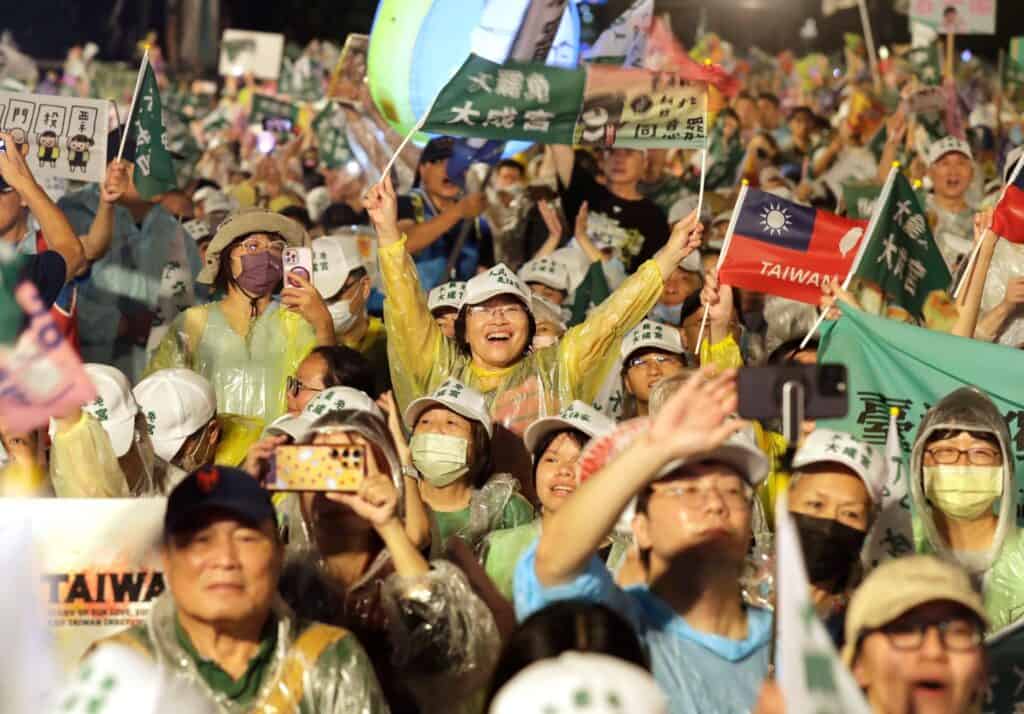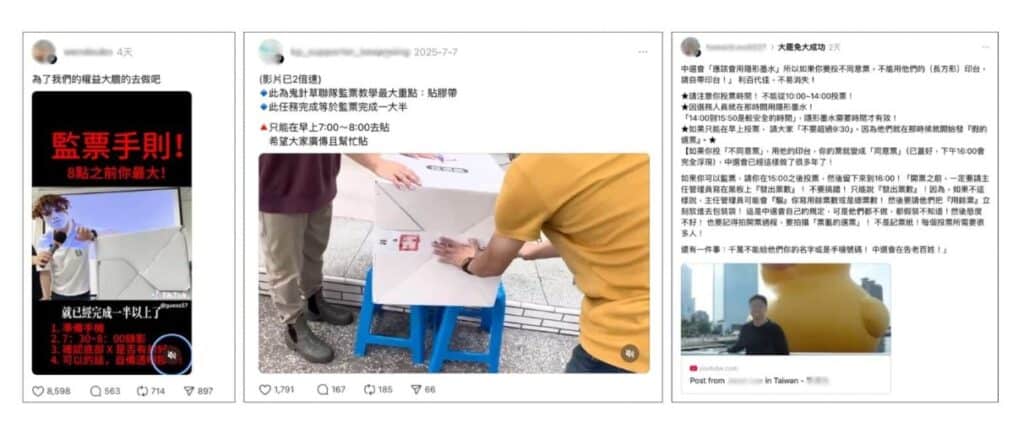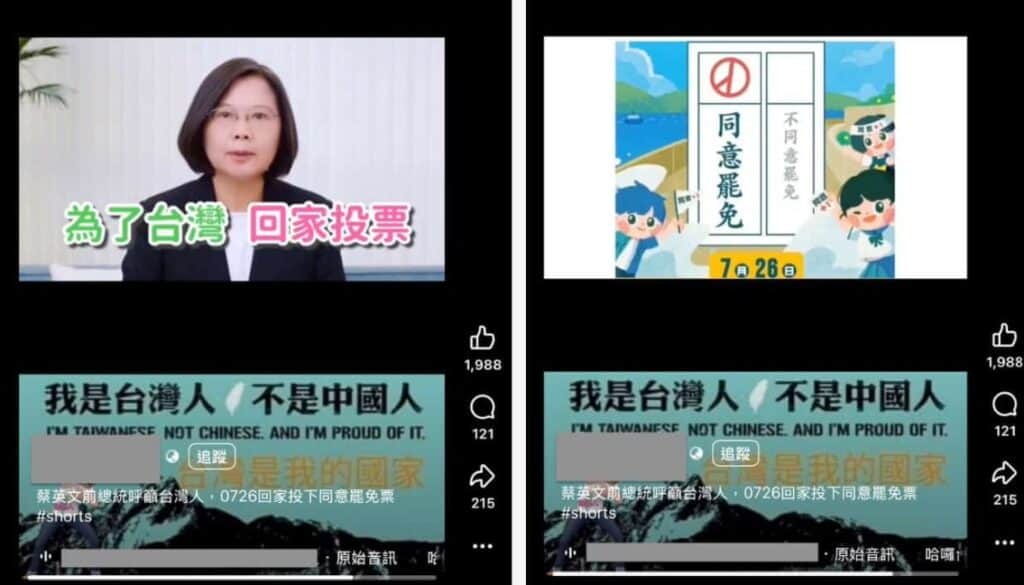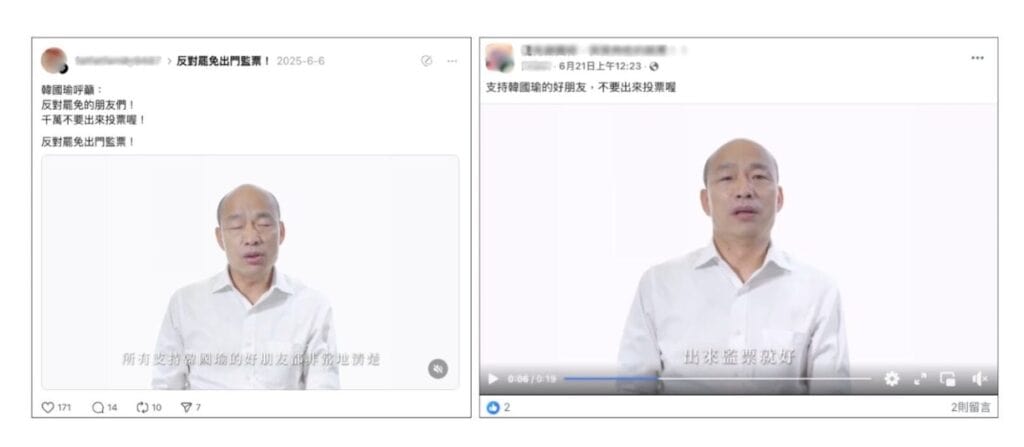
On July 26, 2025, Taiwanese people just finished voting on the first round of the “Great Recall,” in which voters decided whether to remove legislators and one city mayor. During the campaign, new kinds of false information emerged alongside old rumors that were often seen during previous elections. In the month leading up to the election, most false claims focused on the election procedure, with a few attempts to persuade citizens either to vote or not to vote. Besides pieces that maliciously misled voters, most claims reflected Taiwanese society’s anxiety about this unprecedented vote and its results.
The seed of the “Great Recall” was planted right after the legislative election in January 2024, when the Democratic Progressive Party (DPP) lost control of the parliament to the opposition Kuomintang (KMT), even though DPP candidate Lai Ching-te won the presidency in the presidential election held on the same day. The following month, the KMT partnered with the Taiwan People’s Party (TPP), a smaller opposition party that played a key role in the Legislative Yuan, to pass bills that blocked the Lai administration’s policy proposals and significantly cut the budget bills, including plans to strengthen Taiwan’s national defense. The passage of these controversial bills sparked not only many citizens’ frustration over the lack of proper deliberation but also concerns about possible Chinese influence behind the bills’ passage. A wave of large-scale protests, dubbed the “Bluebird movement,” has erupted on the streets since May 2024, with angry citizens voicing their discontent over the hurried legislation and fears of Chinese interference. This anxiety about KMT legislators’ “selling out Taiwan” has deepened among frustrated citizens and further fueled the recall campaigns.
Taiwanese laws have given people the right to recall legislators, but the barriers are high to prevent system abuse. In recent months, the recall proposals cleared the hurdles and became eligible for two rounds of recall votes on July 26 and August 23. However, in the first round, no legislators were removed.
Since the recall bids were successfully submitted, reports of false claims about the recall also rose in June. The Taiwan FactCheck Center tracked these false claims and examined the ones spreading from mid-June to late July. We observed several trends:
- Most false claims relate to the voting procedure.
- These false claims seem to be locally produced and targeted at both pro-recall and anti-recall groups.
- A majority of the false claims were texts that originated and spread on social media that are popular among Taiwanese.
Most false claims are related to the voting procedure. Similar to previous election trends, false claims about the recall votes that emerged during the month before the vote mainly focused on voting information and procedures, such as “problematic ballots” and “suspicious inks.” Some of the false information had already appeared in earlier elections and was debunked. For example, false claims like “the DPP government has replaced transparent ballot boxes with paper-made boxes so that the DPP could do tricks to increase their votes” or “the Central Election Commission uses invisible inks to cheat. Voters should bring their own ink for ballots.”

However, this recall included more prominent false claims warning about location or voting date changes, likely caused by different voting rules for the recall, which led to increased voter confusion. Since mid-June, false information about voting dates has circulated on social media, even before the Central Election Commission announced the official dates for the recall votes. After the dates became public, rumors about voting locations also increased. One widespread claim suggested that local governments controlled by the KMT party had assigned unusual voting sites, different from those in previous elections, hoping to confuse voters and prevent support for the recall. Conversely, some rumors accused the ruling DPP of changing voting locations to discourage voting against the recall. The Taiwan FactCheck Center’s investigation revealed that, although some voting sites had been different from past elections, these adjustments were due to shorter preparation times, which made booking regular polling stations difficult. While it’s true that some locations changed, the conspiracy theories about the motives behind these changes showed the anxiety and worries from supporters on both sides that political parties may manipulate the recall procedures.
In addition to false claims about voting procedures, fake videos were also spread on social media, urging citizens to vote or not to vote. Two widely spread videos made up politicians’ appeals, featuring the former Taiwanese president, Tsai Ing-wen, and the current president of the Legislative Yuan, Han Kuo-yu. In the fake videos of Tsai, Tsai urged citizens to vote, while the fake Han video persuaded citizens otherwise. Both requests aligned with the politicians’ political stance and sounded reasonable to their supporters. However, the footage was edited from old campaign videos used in Tsai’s previous presidential election and Han’s own Kaohsiung mayor recall vote in 2020 (where Han became the first mayor to be recalled in Taiwan’s history).


The origins, dissemination, and targets of the “Great Recall” false claims
As noted earlier, most false information during the recall campaign targeted both pro- and anti-recall groups, mainly concerning voting procedures. These false claims rarely directly addressed issues such as “China’s interference” or “the war with China,” which were key reasons behind the recall. Most of these inaccuracies seem to have originated from concerned local citizens attempting to share information about voting details, like dates (even if incorrect), or alerting others to potential irregularities during voting. Besides false information about voting dates and locations, some citizens also reported suspicious vote counting on recall voting day. However, the alleged flawed vote-counting was later confirmed to be a temporary mistake and was quickly corrected on-site.
Most of these false claims spread on social media platforms popular among Taiwanese users, such as Threads, which gained popularity after the “Bluebird movement,” Reels, a short-video feature accessible through Facebook; and, of course, Facebook itself. In addition to false claims spread by ordinary users, politicians also posted rumors on Facebook about ballots that already had ink on them. The rumor was later proven to be exaggerated claims from the politicians. Additionally, news media reports added to the spread of false information by engaging in poor journalism, amplifying an ambiguous claim that the ruling DPP attempted to manipulate voting rules. However, fact-checkers found this claim to be inaccurate.
Overall, the spread and content of these “Great Recall”-related false information pieces showed signs that the false claims were more locally produced and directly aimed at Taiwanese voters’ concerns rather than originating from overseas sources or social media, which was often seen in many other cases in Taiwan’s information environment (Note 1).
A majority of false claims used a traditional text format
Although AI has increasingly challenged elections worldwide, we saw few AI tools and techniques used in creating false claims during the recall campaign. Most false claims were presented in texts in social media posts. Even the two videos featuring the former Taiwanese president and the president of the Legislative Yuan, which included edited footage from old recordings, could be produced with traditional and simple video-editing tools. However, this does not mean AI-generated images or videos were not used to craft messages intended to influence voters in the recall campaign. This analysis focused only on false claims. In fact, further investigation is needed to understand whether and how AI was employed to produce propaganda, which could deliver accurate facts but aim to sway opinions and perceptions about the recall. As a matter of fact, propaganda tactics could have posed greater threats to democracy and have been another challenge for investigators and researchers studying information influence campaigns.
Note 1: This analysis focuses solely on the content of the information and its traceable sources. Determining the underlying motivations for creating these false claims remains challenging.
Wei-Ping Li is a research fellow at the Taiwan FactCheck Center.
